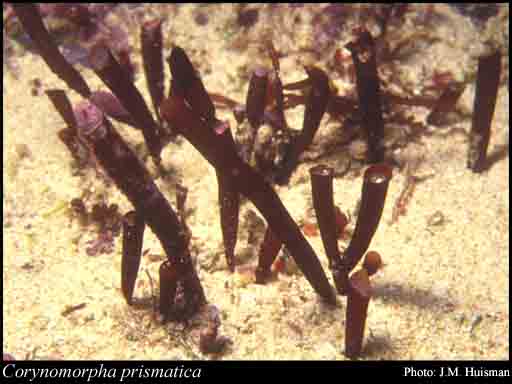- Reference
- Spec.Gen.Ord.Alg. 3(1):143 (1876)
- Conservation Code
- Not threatened
- Naturalised Status
- Native to Western Australia
- Name Status
- Current

Scientific Description
Habit and structure. Thallus deep red, rigid, elongate-clavate, terete, simple or rarely once-divided, to 7.5 cm tall and 5 mm diam., arising from a small discoid holdfast 1–2 mm diam. Structure multiaxial, the medulla a network of slender widely spaced filaments 2–3 µm diam., interspersed with stellate cells, becoming more dense below the cortex, with an abrupt transition to a pseudo- parenchymatous cortex. Cortex 100–200 µm thick, composed of anticlinal fascicles of dichotomous moniliform filaments, in reproductive nemathecia with distal branches 5–7 cells long and 2–3 µm diam.
Reproduction. Reproductive structures borne in slightly swollen apical regions, generally with a slight constriction between the fertile region and the lower thallus. Cystocarps in ampullae, subspherical, 150–250 µm diam., composed entirely of angular carpospores 8–15 µm wide. Other reproductive structures not observed.
Distribution. Known from the Azores, East and West Africa, the Indian Ocean, Queensland and New Caledonia.
Habitat. Generally in clusters on sand-covered rock in shallow water
[After J.M. Huisman & O. De Clerck in Algae of Australia: Marine Benthic Algae of North-western Australia, 2. Red Algae: 280–282 (2018)]
Distribution
- IBRA Regions
- Dampierland.
- IBRA Subregions
- Pindanland.
- IMCRA Regions
- Bonaparte Gulf, Kimberley, Pilbara (nearshore), Pilbara (offshore).
- Local Government Areas (LGAs)
- Ashburton, Broome, Karratha, Wyndham-East Kimberley.